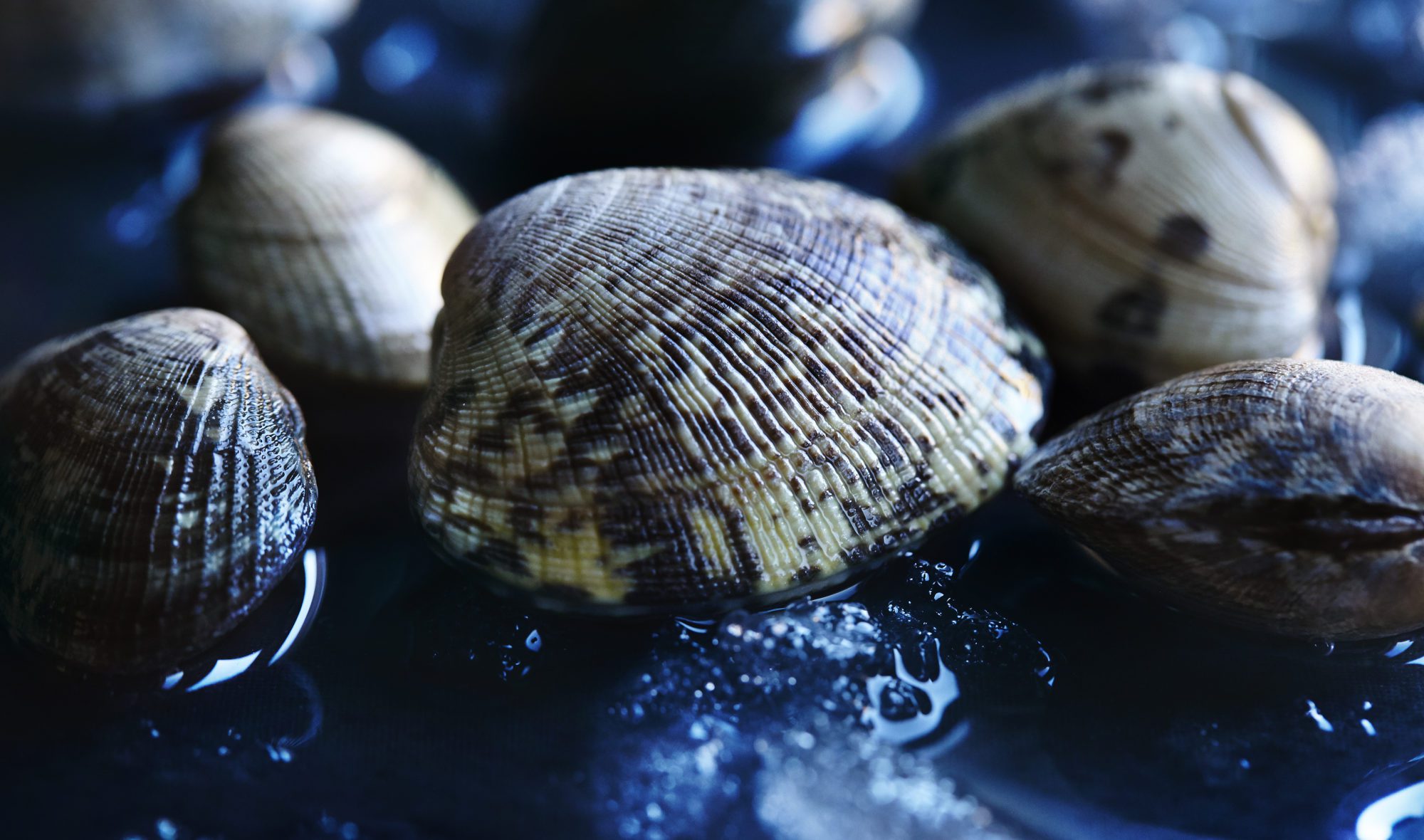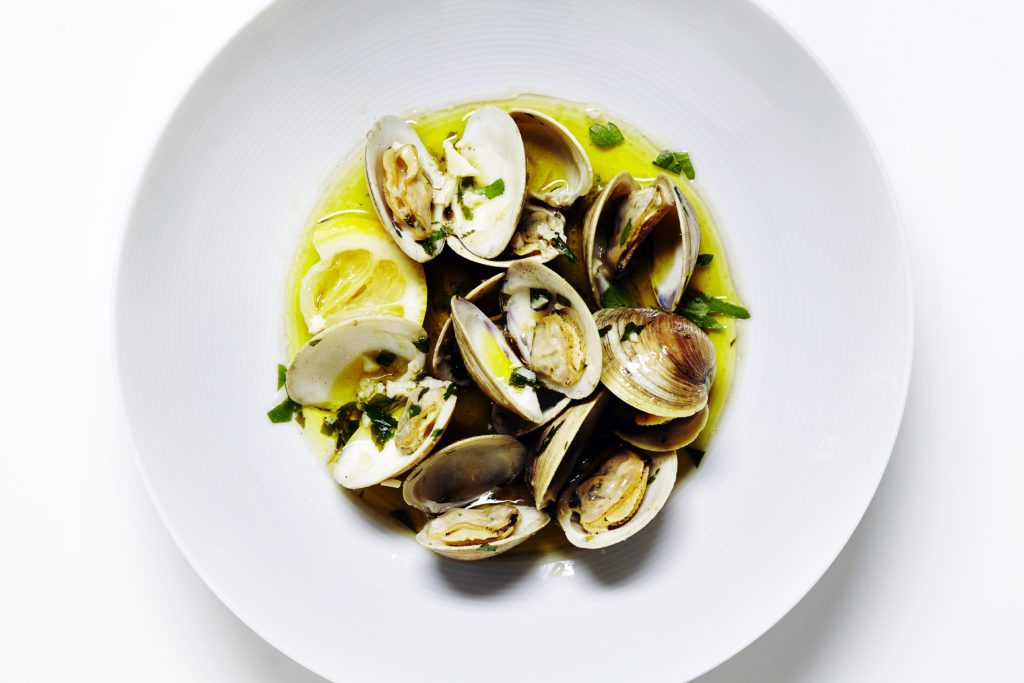
Clams are a type of freshwater or marine dwelling mollusc with a slightly sweet, oceanic flavor. Clams are excellent sources of protein, as well as iron, zinc, selenium, and B12. Clams can be eaten raw or cooked (with minimal seasoning needed) and are commonly found in seafood chowders.
Clams are a type of freshwater or marine dwelling mollusc. They are typically harvested from the Atlantic coasts of Canada and Northern United States.
There are many species of clams. The most common varieties used in North American culinary preparations include: soft-shell clams, surf clams, and ocean quahogs.
Clams have a rich, slightly sweet, oceanic flavor.
Clams are defined by their structure, which involves two hard shells joined by a flexible hinge, encasing a soft body. Clams will range in size, depending on the species selected.
A 100g portion of steamed clams (the meat of about 10 small clams) contains 148 calories, 25.5g of protein, 2.0g of fat, and 5.1g of carbohydrates. Clams are also an excellent source of iron, zinc, selenium, and B12.
Clams contain some cholesterol: about 67mg per 100g serving.
Clams can be purchased in many different forms.
The whole form, with both shells intact, is available fresh and alive or sometimes frozen. The shucked form, with both shells removed, can be found fresh, frozen (either raw or precooked), or canned.
When selecting whole, live clams, look for clams that have closed shells. If shells are open, tap them, and if they respond by closing their shells, they are alive and good to eat. Reject any clams with cracked shells, strong odors, or those that don’t try to close when tapped.
When cooked, the shells of healthy clams will open. Discard any clams that haven’t opened within the suggested cooking time.
Whole clams may be stored in the fridge for up to 14 days after harvesting, preferably over loose ice. Confirm the harvest date with your seafood provider to ensure freshness. Clams may also be frozen for up to three months.
There are a number of ways to prepare clams, but the two simplest forms are raw or steamed.
Raw clams: Purchase fresh, live clams. Wash clams in a colander under cold running water, discarding any that remain open. Using a clam knife, insert the blade into the seam between the shells and twist the knife to open the clam. Run the blade of the knife along the top half of the shell to cut the clam flesh from the shell, then do the same along the bottom half of the shell. Consume as is or with a squeeze of fresh lemon juice or a prepared dressing of choice.
Note: Although the potential for contamination is low when buying from trusted seafood purveyors, the risk for foodborne illness from raw seafood is higher than for cooked versions. Health authorities advise against the consumption of raw seafood among children, elderly adults, pregnant women, or immunocompromised individuals.
Steamed Clams: Rinse clams well under cold running water and discard any that haven’t closed. Letting clams sit in a bowl of lightly salted water for about 10 minutes before steaming will encourage clams to “spit out” any sand or dirt. After soaking, bring a small amount of water, stock, or white wine to boil. In a covered pot, steam clams, shaking the pot occasionally, until all (or nearly all) the clams open, about 10 minutes. Discard any clams that haven’t opened, and serve the rest as desired.

This recipe makes a delicious appetizer. It's quick to prepare and is a great choice for any occasion.
Prep Time: 10 minutes Cook Time: 10 minutes Yield: 4-6 appetizers
Heat a large sauté pan on high heat. Once hot, add 1 tbsp of olive oil. Add the clams to the pan being careful not to add too much water to the pan. Cover the pan and cook for 2 minutes.
Remove the lid and set aside. Allow the clams to cook and fully open up. Once they have all opened up, add the garlic paste and the parsley and combine using a wooden spoon. Add salt and black pepper.
Turn off the heat and add the lemon juice. Mix well.
Place clams onto a serving dish and drizzle with olive oil if desired (quantity of olive oil depends on your preference). Serve with a wedge of lemon.
Enjoy!
Precision Nutrition’s Encyclopedia of Food expands every single month as we highlight new foods and showcase beautiful food photography. If you’d like to stay up to date, simply click this link. From there, we’ll send you a FREE copy of our recipe book. We’ll also let you know when new and delicious foods are added to the site.
Clams are a type of freshwater or marine dwelling mollusc with a slightly sweet, oceanic flavor. Clams are excellent sources of protein, as well as iron, zinc, selenium, and B12. Clams can be eaten raw or cooked (with minimal seasoning needed) and are commonly found in seafood chowders.